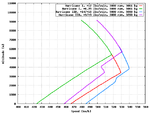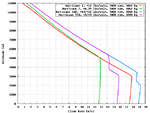michaelmaltby
Colonel
I'm hoping that fans of Hawker Hurricane can add insight to what is known/written about the Hurricane. I have always preferred the B-of-B-era Hurri to the Spit. At that point neither had cannons I believe, just 303 MG's. Once the B-of-B was over, the HH and the Spit immediately started to evolve in completedly different platforms - the HH becoming a ground attack aircraft with cannons-only + rockets (or bombs) - the Spit becoming the cannon+MG platform to kill FW-190's and 109 E&G's anywhere from top cover escort to the deck.
In its evolutionary process the Spit has received plenty of well-deserved attention - the Hurricane much less.
Think on it - not as many HH's were built as Spits but they were produced from 1936 (ish) until 1944. In 1940, as an interceptor made largely with bi-plane canvas covered tube steel frame + wood technologies it scored the lion's share of B-of-B kills, and four years later it's on the deck with rockets along with the Typhoons.
So that's the thread I hope to see start here - are there gents out there with close detail experience and knowledge to share about of how Hawker kept refining the Hurricane as a platform to keep it in the fight.
Things to consider: Hawker (plus 3rd parties like Gloster) had production of 2 platforms going at once: Hurri and Typhoon. They were also building in Canada at CanCar Thunder Bay with Packards. [Google *Hurricane Elsie McGill*]. Supermarine was totally focused on Spits (Walruses aside).
Also: Typhoon was not a great initial success - power plant or air frame - so the Hurricane HAD to keep serving competitively.
Finally: both Hurris and Spits were also evolved for onboard FLA service.
The *killer flaw* of the Hurricane seems to have been the fuel tank directly in front of the pilot.
So, do I have any takers ...? It's a worthy thread.
Chairs,
Michael Maltby
Toronto
In its evolutionary process the Spit has received plenty of well-deserved attention - the Hurricane much less.
Think on it - not as many HH's were built as Spits but they were produced from 1936 (ish) until 1944. In 1940, as an interceptor made largely with bi-plane canvas covered tube steel frame + wood technologies it scored the lion's share of B-of-B kills, and four years later it's on the deck with rockets along with the Typhoons.
So that's the thread I hope to see start here - are there gents out there with close detail experience and knowledge to share about of how Hawker kept refining the Hurricane as a platform to keep it in the fight.
Things to consider: Hawker (plus 3rd parties like Gloster) had production of 2 platforms going at once: Hurri and Typhoon. They were also building in Canada at CanCar Thunder Bay with Packards. [Google *Hurricane Elsie McGill*]. Supermarine was totally focused on Spits (Walruses aside).
Also: Typhoon was not a great initial success - power plant or air frame - so the Hurricane HAD to keep serving competitively.
Finally: both Hurris and Spits were also evolved for onboard FLA service.
The *killer flaw* of the Hurricane seems to have been the fuel tank directly in front of the pilot.
So, do I have any takers ...? It's a worthy thread.
Chairs,
Michael Maltby
Toronto


